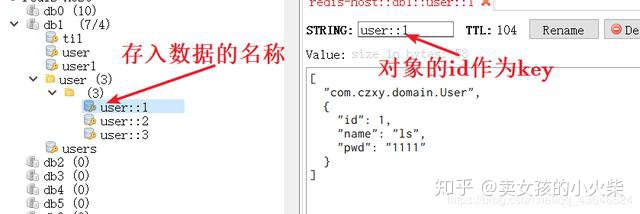SpringBoot使用Redis实现 自动缓存 更新 删除
本篇主要讲述如何使用基本的注解 @Cacheable @CachePut @CacheEvict 操作缓存
1.我们导入Redis的依赖
<!--这里Redis我给了版本-->
<dependency>
<groupId>org.springframework.boot</groupId>
<artifactId>spring-boot-starter-data-redis</artifactId>
<version>1.5.10.RELEASE</version>
</dependency>
<dependency>
<groupId>org.springframework.boot</groupId>
<artifactId>spring-boot-starter-cache</artifactId>
</dependency>
<!--使用配置类时,防止乱码需要用到的包-->
<dependency>
<groupId>org.springframework.boot</groupId>
<artifactId>spring-boot-configuration-processor</artifactId>
<optional>true</optional>
</dependency>
2.编写配置类
@ConfigurationProperties(prefix = "spring.cache.redis")
@Configuration
public class RedisConfig {
private Duration timeToLive = Duration.ZERO;
public void setTimeToLive(Duration timeToLive) {
this.timeToLive = timeToLive;
}
@Bean
/**
* 该bean只针对cache存入到数据乱码问题
*/
public RedisCacheManager cacheManager(RedisConnectionFactory factory) {
RedisSerializer<String> redisSerializer = new StringRedisSerializer();
Jackson2JsonRedisSerializer jackson2JsonRedisSerializer = new Jackson2JsonRedisSerializer(Object.class);
//解决查询缓存转换异常的问题
ObjectMapper om = new ObjectMapper();
om.setVisibility(PropertyAccessor.ALL, JsonAutoDetect.Visibility.ANY);
om.enableDefaultTyping(ObjectMapper.DefaultTyping.NON_FINAL);
jackson2JsonRedisSerializer.setObjectMapper(om);
// 配置序列化(解决乱码的问题)
RedisCacheConfiguration config = RedisCacheConfiguration.defaultCacheConfig()
.entryTtl(timeToLive)
.serializeKeysWith(RedisSerializationContext.SerializationPair.fromSerializer(redisSerializer))
.serializeValuesWith(RedisSerializationContext.SerializationPair.fromSerializer(jackson2JsonRedisSerializer))
.disableCachingNullValues();
RedisCacheManager cacheManager = RedisCacheManager.builder(factory)
.cacheDefaults(config)
.build();
return cacheManager;
}
}
3.配置文件
#要连接的数据是哪个
spring.redis.database=1
#数据连接地址
spring.redis.host=localhost
#端口号
spring.redis.port=6379
#连接超时时间
spring.redis.timeout=1s
#最大连接数
spring.redis.jedis.pool.max-active=20
#最大空闲连接
spring.redis.jedis.pool.max-idle=20
#最小空闲连接
spring.redis.jedis.pool.min-idle=10
#最大等待阻塞等待时间
spring.redis.jedis.pool.max-wait=-1ms
#在写入Redis时是否要使用key前缀
spring.cache.redis.use-key-prefix=true
#key前缀
spring.cache.redis.key-prefix=dev
#是否允许有null值
spring.cache.redis.cache-null-values=false
#设置缓存存在时间,只针对cacheable存入数据有用
spring.cache.redis.time-to-live=120s
4.现在我们的环境准备好了,开始编写代码
这里是pojo
@Table(name = "user1")
public class User implements Serializable {
@Id
private Integer id;
private String name;
private String pwd;
public Integer getId() {
return id;
}
public void setId(Integer id) {
this.id = id;
}
public String getName() {
return name;
}
public void setName(String name) {
this.name = name;
}
public String getPwd() {
return pwd;
}
public void setPwd(String pwd) {
this.pwd = pwd;
}
@Override
public String toString() {
return "User{" +
"id=" + id +
", name='" + name + ''' +
", pwd='" + pwd + ''' +
'}';
}
}
这里是dao类
@org.apache.ibatis.annotations.Mapper
public interface UserMapper extends Mapper<User> {
}
这里是在service类上使用注解
@CacheConfig(cacheNames = "user")//注意,用于同一配置给其它注解配置名称
public class UserServiceImpl implements UserService {
@Autowired
private UserMapper userMapper;
@Override
@Cacheable(key="#p0")//该注解用于向缓存中存入数据
public User findUser(Integer id) {
System.out.println("查询数据了"+id);
User user = userMapper.selectByPrimaryKey(id);
return user;
}
@Override
@CachePut(key="#p0.id")//该注解用于更新缓存中的注解
public User updateUser(User user) {
userMapper.updateByPrimaryKeySelective(user);
return user;
}
@Override
@CacheEvict(key="#p0")//该注解用于删除缓存
public void deleteUser(Integer id) {
userMapper.deleteByPrimaryKey(id);
}
@Override
public List<User> findUsers() {
return userMapper.selectAll();
}
}
注意,这里需要说明一下,#p0代表第一个参数,返回值默认是方法的返回值,@Cacheable之类的注解必须要有value值,这里我在类上加@CacheConfig注解,使下面的注解有了同一个value值
这里是controller里面的代码
@RestController
@RequestMapping("/user")
public class UserController {
@Resource
private UserService userService;
@GetMapping
public ResponseEntity<List<User>> findUsers(){
try {
List<User> users = userService.findUsers();
return new ResponseEntity<>(users,HttpStatus.OK);
} catch (Exception e) {
e.printStackTrace();
return new ResponseEntity<>(HttpStatus.INTERNAL_SERVER_ERROR);
}
}
@GetMapping("/{id}")
public ResponseEntity<User> findUser(@PathVariable("id")Integer id){
try {
User user = userService.findUser(id);
return new ResponseEntity<>(user, HttpStatus.OK);
} catch (Exception e) {
e.printStackTrace();
return new ResponseEntity<>(HttpStatus.INTERNAL_SERVER_ERROR);
}
}
@PutMapping
public ResponseEntity<String> updateUser(@RequestBody User user){
try {
userService.updateUser(user);
return new ResponseEntity<>("修改成功",HttpStatus.OK);
} catch (Exception e) {
e.printStackTrace();
return new ResponseEntity<>(HttpStatus.INTERNAL_SERVER_ERROR);
}
}
@DeleteMapping("/{id}")
public ResponseEntity<Void> deleteUser(@PathVariable("id")Integer id){
try {
userService.deleteUser(id);
return new ResponseEntity<>(HttpStatus.OK);
} catch (Exception e) {
e.printStackTrace();
return new ResponseEntity<>(HttpStatus.INTERNAL_SERVER_ERROR);
}
}
}
5.这里是数据库的数据

6.好了,后台代码到这基本就完成了,现在自己编写一下前台,完成测试
- 最后说一下需要注意的点,配置文件中的时间配置规定了缓存存在的时间,这里我设置的是120s
- 这里的配置类必须这样配置,否则,存入到数据的数据会乱码
- 更新的时候,注意方法的返回值,否则数据存入的数据为null




















 1万+
1万+











 被折叠的 条评论
为什么被折叠?
被折叠的 条评论
为什么被折叠?








